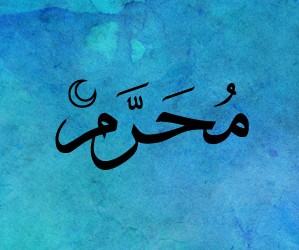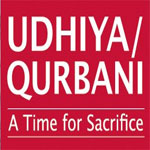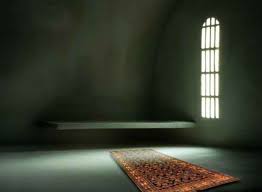Afaqi: Afaqi is the person who lives outside Miqat boundaries such as Indian, Pakistani, Egyptian, Syrian, Iraqi, Iranian and so on.
Ash-hur-E-Hajj: The months of Hajj i.e. complete months of Shawwal, Zi-Qa’da and half of the month of Zilhijja.
Ayyam-e-Tashriq: The days from 9th to 13th Zilhijja wherein Takbir-e-Tashriq is regularly proclaimed.
Bab-us-Salam: With this name there is a gate of Masjid-ul-Haram in Mecca. The first entrance to the Sacred Mosque is preferable through this gate. Another gate with the same name is in Madina. This is the gate of Masjid- e-Nabawi opening on the side of market.
Batn-e-‘Urana: This is a jungle near ‘Arafat wherein the observance of Waqof is not Lawful, for it is out of ‘Arafat boundaries.
Bab-e-Jibril: Through this gate Hazrat Jibril, the angel, used to visit the Holy Prophet (Peace be upon him). This is the gate through which we go to Jannat-ul-Baqi’.
Dam: During Ihram, perpetration of certain prohibited acts causes the obligation of offering sacrifice of a goat etc. It is called Dam.
Ghar-e-Hira: It is the cave where the first revelation was sent down to the Holy Prophet (Peace be upon him). It is situated in Jabal-e-nor which is on the roadway to Mina. Its top is visible from far off.
Ghar-e-Thaur: In this cave the Holy Prophet (Peace be upon him) stayed for three days at the time of his migration (Hijrat) from Makkah.
Hajar-e-Aswad: The black stone. It is a stone from Paradise. It was white like milk when it came from the Paradise but the sins of the human beings rendered it black. It is fixed in the wall at about a man’s height in the southeastern corner of Baitullah. It has a silver frame around it.
Hudaibia: It is the name of a place before the precincts of Haram on the way from Jedda to Mecca. Nowadays, it is known by the name of Sumaisiya. A mosque is situated on this very spot. Here, the Holy Prophet entered into a treaty with the infidels and it is the place where the Holy Prophet (Peace be upon him) took an oath of allegiance, Bai’at-ur-Ridhwan by name from his noble companions. It is the starting point of the precincts of Haram.
Hatim: It is a piece of land surrounded by a wall of man’s height adjacent to Baitullah on the north side. It is called Hatim as well as Ahjar or Hazira. While observing Tawaf it is Wajib (obligatory) to include this piece of land. It is a part of Ka’ba. In Pre-Islamic period when Quraish of Mecca started reconstruction of Ka’ba, they abandoned construction of this portion due to deficiency in Halal (lawfully acquired) funds.
Haram: Mecca and a small area around it is called the Land of Haram. Its boundaries have been distinctly marked. Hunting, cutting trees and grazing animals in Haram (unlawful) in this area.
Harami or Ahl-e-Haram: The person who lives in the land of Haram; whether in Mecca or outside Mecca within the precincts of Haram.
Hill: The land beyond the four sides of Haram upto Miqat (i.e. outside the Haram boundaries but inside the Mawaqit) is called Hill, for the things prohibited (Haram) in Haram are permissible (Halal) here.
Hilli: The inhabitant of the land of Hill.
Halq: To get the hair of your head shaven or to shave them yourself. It releases you from the restrictions of Ihram.
Ihram: Means to declare a thing as Haram (Forbidden). When a Hajj Pilgrim determines his intention for Hajj, Umra or both collectively and proclaims Talbia, certain Halal (Permissible) things stand for him as Haram; hence it is called Ihram. This word is used figuratively for those sheets of cloth as well which are used by Hajj pilgrims in the state of Ihram.
Istilam: To Kiss as well as to touch Hajare-Aswad with hands or only to touch it or to touch Rukn-e-Yamani.
Idhtiba: To put the upper cover of Ihram on the left shoulder by way of taking the cover through the right armpit.
Ifrad: To observe Hajj practices with the Ihram of Hajj only.
Jamarat or Jimar: There are three places in Mina where pillars of the height of man have been erected. Here, pebbles are thrown. One of them which is towards the East near Masjid-e-Khaif is called Jamrat-ul’Ola. The next one to it is named as Jamrat-ul-Wusta and the one subsequent to it is known as Jamrat-ul-Kubra. The last one is also called as, Jamrat-ul-‘Aqaba or Jamrat-ul-‘Ukhra.
Juhfa: It is a place near Rabigh at a distance of three Manzils (encampment distances) from Mecca. This is the Miqat for those coming from Syria.
Jannat-ul-Ma’la: It is the graveyard of Makkah where Umm-ul-Mu’minin (The Mother of the faithful) Hazrat Khadijat-ul-Kubra and the dear son of the Holy Prophet (Peace be upon him) and some of his faithful companions have been interred. The grave of Hazrat Haji Imdadullah Muhajir Makki is also situated here.
Jannat-ul-Baqi’: It is the Graveyard of Madina where the uncle the uncle of the Holy Prophet, (Peace be upon him) Hazrat Abbas, Hazrat Imam Hasan, Hazrat Uthman and thousands of other noble companions of the Holy Prophet have been interred. In addition to that, among those buried here are also the son of the Holy Prophet, Hazrat Ibrahim, Hazrat Fatima, Hazrat Halima Sa’dia and all other Ummahat-ul-Mu’minin (the Mothers of the faithful) with the exception of Hazrat Maimona as the place of her burial is Sarif.
Jabal-e-Thabir: It is a hill in Mina.
Jabal-e-Rahmat: It is a hill in ‘Arafat.
Jabal-e-Quzah: It is a hill in Muzdalifa.
Jabal-e-‘Uhud: It is a hill outside Madina at a distance of nearly three miles where the battle of ‘Uhud was fought. Here are the graves of the martyrs.
Jabal-e-Abu Qubays. It is the name of a hill in Mecca near Safa. Here is a mosque called Masjid-e-Bilal. Some of the biographers have stated that the miracle of Shaqq-ul-Qamar (splitting of the moon in two halves) was revealed here.
Ka’ba the Sacred: The Ka’ba, which is also known as Baitullah, is a sacred house in the center of Masjid-e- Haram in Mecca. It is the first place of worship in the world. It was originally constructed by angels under the order of Allah the most high even before the birth of Hazrat Adam. Subsequently on its demolition Hazrat Adam reconstructed it. Thereafter it was reconstructed by the Holy Prophet Hazrat Ibrahim, then by Quraish, then by Hazrat Abdullah ibn Zubair (Radhi-Allahu ‘anhu) and then by Abdul Malik. Even in the later ages, certain repairs continued to be carried out. It is the Qibla of Muslims. All the Muslims in the world turn their faces towards it while offering their prayers.
Muhrim: One who wears Ihram.
Mufrid: One who were Ibrahim for Hajj only.
Miqat: The place where Ihram wearing is Wjib for those who go to Mecca.
Miqati: The inhabitant of Miqat.
Mataf: The place around Baitullah in Masjid-e-Haram to perform Tawaf.
Maqam-e-Ibrahim: It is a stone from Paradise. Standing on it, the Holy Prophet Hazrat Ibrahim had constructed
Baitullah: Nowadays, it is included in Mataf.
Masjid-e-Haram: The Mosque around Ka’ba.
Multazam: The wall between Hajar-e-Aswad and the gate of Baitullah. It is Masnon (prescribed as Sunnah of our Prophet) to invoke blessings of Allah while embracing this wall.
Mina: It is a vast open field between two hills at a distance of 3 miles from Mecca towards the East. Rami and Sacrifice are accomplished here. It is included in Haram. A stay of three days is observed here.
Masjid-e-Khaif: It is the name of big Mosque in Mina situated adjacent to the hill on the northern side of Mina.
Masjid-e-Namra: A Mosque on one side of ‘Arafat.
Mad’a: The Place of invocation. It means the place, which is situated between Masjid-e-Haram and the graveyard of Mecca and where invoking Allah’s blessing is Mustahab (preferred) at the time of entering Mecca.
Muzdalifa: It is open field between Mina and ‘Arafat at a distance of about three miles from Mina in the East. On having returned from ‘Arafat, the Hajj Pilgrims stay here at night.
Muhassir: It is an open field adjacent to Muzdalifa. The Divine punishment had descended upon the people of Elephant (Ashab-ul-Fil) here, who had invaded Baitullah. That is why the pilgrims cross it running.
Marwa: It is a small bill near the northeastern corner of Baitullah. The Sa’i ends here.
Masjid-ul-Raya: This Mosque is on the way to Jannat-ul-Ma’la. On the day of the Conquest of Mecca, the Holy Prophet had erected this flag here.
Masjid-e-Quba: It is a Mosque three miles before the boundaries of Medina. The Holy Prophet (Peace be upon him) himself participated in its construction. It is the first Mosque of Muslims in the vicinity of Madina. Offering two Raka’at of Nafl (supererogatory) prayer, here is equivalent to one Umra in reward and it is Mustahab to visit this Mosque on a Saturday.
Masjid-e-Khandaq: There are some Mosques constructed on the place where, at the time of the battle of Ahzab, the ditch was dug. One of the Mosques is called Masjid-e-Ahzab and Masjid-e-Fath. Here, the Holy Prophet (Peace be upon him) prayed to Allah and Allah granted the prayer ; the Muslims were victorious. Around this mosque there are several other mosques attributed to the names of the Companions of the Holy Prophet.
Masjid-e-Qiblatain: It is mosque on the hillock near the valley of Aqiq in the North West of Medina. It has two arches, one towards Bait-ul-Maqdis and the other towards the Ka’ba, For, this is the mosque where the event of the change of Qibla occurred and that is why it is called Masjid-e-Qiblatain.
Masjid-e-Bani-Zafar: It is also called Masjid-e-Baghla. It is situated towards the East of Jannat-ul-Baqi’. The tribe of Bani Zafar used to live here. Once the Holy Prophet (Peace be upon him) honoured this place with his presence and at his desire, one of his Companions recited Sura-e-Nisa to him. Near the Mosque there is a hoof- mark of the mule of the Holy Prophet (Peace be upon him) and that is why it is also called Masjid-ul-Baghla.
Masjid-ul-Ijaba. This mosque is in the northern side of Jannat-ul-Baqi’. The Holy Prophet (Peace be upon him) had prayed here.
Mash’ar-e-Haram: It is a mosque in Muzdalifa but a hill of Muzdalifa, Jabal-e-Quzah by name is also called Mash’ar-e- Haram.
Mas’a: The place for performing Sa’r (running between Safa and Marwah.)
Mauqif: The place for having a stay. It means the place of stay in the open field of ‘Arafat or in Muzdalifa.
Mizab-e-Rahmat: The water-outleft of the roof of Ka’ba falling in Hatim. One should pray to Allah while standing beneath it as the invocations offered here are accorded approval.
Qiran: To Perform Umra and Hajj successively after wearing Ihram collectively for Hajj and Umra both.
Qarin: One who performs Qiran.
Qarn: It is a hill at a distance of about forty two miles from Mecca. It is the Miqat for those coming from Najd-e- Yemen, Najd-e-Hijaz and Najd-e-Tihama.
Qasr: To have your hair cut or to cut them yourself in order to be out of Ihram.
Rukn-e-Iraqi: The north eastern corner of Baitullah towards Iraq.
Rukn-e-Yamani: The south western corner of Baitullah towards Yemen.
Rukn-e-Shami: The northwestern corner of Baitullah towards Syria.
Ramal: To walk a bit fast in the first three rounds of Tawaf with steps close to each other shaking shoulders struttingly.
Rami: To throw pebbles on Jamarat.
Sa’I: To have seven rounds in a defined mode between Safa and Marwa.
Shaut: We complete seven circuits around Baitullah. Every circuit is called Shaut. At the time of Sa’i between Safa and Marwa the round made from Safa to Marwa is also known as shout. Similarly the back round from Marwa to Safa is the 2nd Shaut and so on upto the seventh Shaut.
Safa: A hill near Ka’ba towards the south werefrom the Sa’i takes a start.
Tamattu’: To observe ‘Umra in the months of Hajj in the first instance and then to perform Hajj in the same year with the Ihram of Hajj.
Takbir: To proclaim Allah-o-Akbar.
Talbiyya: To proclaim Labbaik Allahumma Labbaik; etc.
Tahlil: To proclaim La Ilaha Illallah.
Tan’im: It is a place where, at the time of their stay at Mecca, people wear Ihram for Umra. It is at a distance of 3 miles from Mecca and is the nearest place from the precincts of Haram. Here is a Mosque named Masjid-e-Aisha.
Tawaf: Circumambulation of the Ka’ba.
Tawaf-e-Qudom: The first Tawaf, observed by Hajj pilgrims immediately after reaching Mecca, is called Tawaf- e-Qudom or Tawaf-e-Tahiyya. It is Sunnat for a Qarin and a Mufrid Afaqi.
Tawaf-e-Ziyarat: The Tawaf performed after Waqof-e-Arafat. It is also known as Tawaf-e-Rukn for it is Fardh (Divine obligation) in Hajj.
Tawaf-e-Sadr: The Tawaf performed at the time of departure from Mecca is called Tawaf-e-Sadr or Tawaf-e- Wida.
Umrah: To perform Tawaf of Baitullah alongwith Sa’i between Safa and Marwa after wearing Ihram from Hill or Miqat.
Yaum-e-Arafa: The ninth Zilhajja, the day when Hajj is performed and the pilgrims have to stay at ‘Arafat.
Yaum-ut-Tarviya: The eighth Zilhijja.
Yalamlam: It is a hill at a distance of two Manzils (encampment distances) from Mecca towards the south. It is also known as Sa’diya nowadays. The sea traveling pilgrims from our country wear Ihram at this place when they reach the point confronting to it.
Zulhulaifa: It is the name of a place situated at a distance of about six miles on the way from Madina to Mecca. It is the Miqat for those who come from Madina and is known nowadays by the name of Bir-e-‘Ali.
Zat-u-‘Irq: It is the name of place, which is desolate nowadays. It is as a distance of about three days journey towards Iraq from Mecca. It is the Miqat for those coming from Iraq.
Zamzam: In Masjid-e-Haram near Baitullah, it is a well to which Almighty Allah, out of his Devine power, made a spring of water to flow for the sake of His Prophet Hazrat Isma’il and his mother (peace be upon him). It has been running for thousands of years till now.
Book: Hajj: Merits & Precepts
Author: Mufti Muhammad Taqi Usmani (DB)



